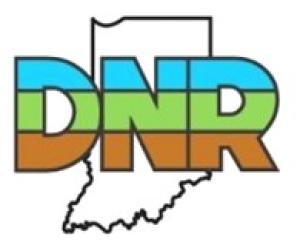
Summer days at the range
Indiana DNR public shooting ranges are located at many Fish & Wildlife areas around the state. The ranges offer a safe and controlled environment for a fun day of honing your archery, trap, skeet, pistol, or rifle skills with family and friends. If you’re new to shooting sports and interested in learning more, we encourage you to stop by a range.

Image captured at Willow Slough Fish & Wildlife Area
Range users must be at least 18 years old or accompanied by someone who is at least 18 years old. The ranges vary in operating times and pricing, so check out the DNR Shooting Range webpage for more information.

Camping and fishing are a perfect combo
Camping season has arrived! When packing your tent or preparing the camper this summer, remember the tackle box and fishing poles. Waking up to the sound of birds and going down to the water to catch some fish is the kind of relaxation everyone could benefit from.
The still waters of an early morning are a great time to watch the fish “wake up” and tap their noses against the surface, looking for that early breakfast bite. So, take your camping chair, throw a line, and recharge in the beautiful Indiana outdoors.
Check out the DNR Where To Fish map to find public waters near your campsite.

2025-2026 migratory bird hunting seasons announced
Indiana’s migratory bird hunting seasons for 2025-2026 have been submitted to the U.S. Fish and Wildlife Service. These seasons include those for mourning doves, waterfowl (ducks, coots, mergansers, and geese), woodcock, snipe, and sora rails.
The Canada goose daily bag limit is five Canada geese and may include brant in aggregate in any combination of the two species. The daily bag limit for light geese (snow and Ross’s geese) remains 20. The white-fronted goose season is separate from the season for other geese. The daily bag limit is two white-fronted geese.
There is one change in duck bag limits from last year’s season. The daily bag limit for pintails will be three. The scaup daily bag limit will stay as a limit of one during the first 15 days of the duck season, and a limit of two for the rest of the season.
The possession limit for all migratory birds is three times the daily bag limit, except for light geese, for which there is no possession limit.

Join Adopt-A-Ramp volunteers and make a difference
We know Indiana anglers, boaters, and paddlers care about clean waterways, healthy wildlife, and quality public access sites. If you are looking for a meaningful and flexible opportunity to give back to a resource you value, consider becoming an Adopt-A-Ramp volunteer.
By collecting trash and discarded fishing line, reporting maintenance needs, or tackling other projects, this is a great opportunity for individuals, families, and groups to make a positive impact. We have more than 400 public access sites in Indiana, so there’s sure to be a spot near you. Volunteers commit for one year at a time and can renew year to year.
To become an Adopt-A-Ramp volunteer, visit the DFW Volunteer webpage to create a volunteer account and sign up.

Reel in some Skamania steelhead
Try your hand at fishing for Skamania steelhead this summer as these fish return to Indiana’s tributaries to spawn in mid- to late June. Skamania is a unique species of summer-migrating steelhead trout that the DNR stocks in southern Lake Michigan.
Many of the streams where these fish can be found have easy bank access or piers, providing easy access to catch a steelhead. As far as gear, a medium action rod, a bobber, and bait like night crawlers or cooked, peeled shrimp will work well.
Streams where you can catch Skamania steelhead include Salt Creek, the East Branch of the Little Calumet River, the St. Joseph River, and Trail Creek (widely known to be the best fishing for Skamania). You can catch these fish in Indiana throughout June and July.

Last chance to volunteer to support 2025 wildlife research efforts
Do you enjoy viewing wildlife? Do you take steps to prevent wildlife-related damage to your property? We are looking for summer volunteers to track wildlife sightings and related activities around their home. The data collected will be used in the final segment of a year-long research project with Purdue University to better understand the economic impact of wildlife in our state.
Each volunteer selected to participate will receive a logbook to report wildlife encounters along with related activities—such as feeding or repairing damage—and expenditures. In exchange, you may be eligible for a cash reward.
If you are interested in participating, please register here. After registering, there will be a link to a consent form through Purdue University with further details about the project.

Listen for the “bob-WHITE!”
One of the easiest birds to identify by their call alone is the Northern bobwhite. It’s two whistled notes that sound like: “bob-WHITE!”
The call of what’s also known as Virginia quail or bobwhite quail is not only one of the most beautiful sounds in nature, but also is an extremely useful tool in estimating their populations. Every spring, biologists across the state conduct spring whistle count surveys. From June 10-30, counts will be conducted at sunrise along a 14-mile route with stops every mile. Observers listen for three minutes per stop and count how many quail are calling. There are 65 of these 14-mile routes across the state where DNR biologists will collect data to determine the locations of quail. Through the number of quail heard calling in one area, biologists determine the quality of habitat and/or how quail are responding to habitat management efforts.
Interested in knowing how many quail live near you? Grab a notebook and a pen and spend an hour or two at sunrise listening for their beloved whistle at your local DNR property or on your own land. It’s a fun opportunity to connect with nature, and you might hear more than you think.

Bat enthusiasts visit Indiana from far and wide
The DNR mammalogy team recently organized a field day at Wyandotte Cave in Crawford County for bat biologists and wildlife professionals. At the event, DNR biologists counted the number of different species that left the cave to feed that evening, and the U.S. Fish & Wildlife Service collected genetic samples that included important health data. The DNR also hosted wildlife professionals who needed to log hours in bat-handling and species identification. Space was limited, and external participants were drawn from a lottery. Some attendees traveled from Kentucky, Pennsylvania, and Massachusetts for the event.
Participants gained valuable experience with five of the six different species of cave bats that exist in Indiana including the Indiana bat, little brown bat, big brown bat, gray bat, and tricolored bat. Indiana’s six cave-roosting bat species, apart from the big brown bat, are all state-endangered. Monitoring their populations and collecting health data is essential for their continual existence in Indiana.
This important work is supported, in part, by the Indiana Nongame Wildlife Fund. You can help us continue our efforts for rare and endangered species by donating.

Recent news releases
- Migratory bird hunting seasons announced
- Changes made to stream trout stockings
- Stream trout opener set for last Saturday of April
- Nearly 4,000-acre Fish & Wildlife Area opens in southern Indiana
- Hoosier anglers can take Midwest Walleye Challenge
Upcoming events
- Jun 07: Free Fishing Day, Statewide
- Jun 08: Free Fishing Day, Statewide
- Jun 12: Sandhill Crane Migration Game, Goose Pond FWA
- Jun 13: Visitors Center Landscape Beautification, Goose Pond FWA
- Jun 17: Flying WILD Workshop, Bristol
- Jun 21: Annual Frog Gigging Night, Goose Pond FWA
- Jun 26: Name That Adaptation & Dance Like a Crane, Goose Pond FWA
More
- Buy a license
- Hunting information
- Where to Hunt
- Fishing information
- Where to Fish
- Fish & Wildlife properties
About Fish and Wildlife Management in Indiana
Fish and wildlife management and public access are funded by fishing and hunting license revenue and also through the Wildlife and Sport Fish Restoration Programs administered by the U.S. Fish & Wildlife Service. These programs collect excise taxes on sporting arms and ammunition, archery equipment, fishing equipment, and motorboat fuels. The money is distributed among state fish and wildlife agencies based on land size and the number of licensed anglers and hunters in each state. Find out more information about fish and wildlife management in Indiana at wildlife.IN.gov.
